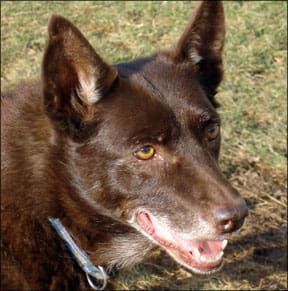TRAINING OLD DOGS: OVERVIEW
1. Make a commitment to continue providing your aging dog with learning and training opportunities as long as he can enjoy them.
2. Be realistic in your expectations about what your senior dog can learn. Don’t ask him to perform beyond his physical capabilities.
3. Consult with your veterinarian if you see signs of canine cognitive disorder (mental aging) in your dog.
You’ve no doubt heard the adage, “You can’t teach an old dog new tricks.” If you have an older dog, you’ll be relieved to know that for the most part it’s false. Older dogs are perfectly capable of learning. The oldest dog ever to enroll in one of my training classes was an 11-year-old Labrador Retriever, and she performed admirably. Positive trainers like to say “it’s all tricks.” Any new behaviors your senior dog can learn count as new tricks, even if he’s no longer jumping through hoops.

There are a number of factors that influence how much and what your mature canine pal can learn, including:
1. Your dog’s training and behavior history.
If your dog has learned how to enjoy learning and is engaged in an ongoing training program, he will continue to learn easily. Studies show that humans who continue to exercise their brains stay more mentally alert than those who do not. We have every reason to believe the same is true of dogs.
2. Physical conditions that limit his mobility.
It seems obvious but we’ll say it anyway: If your dog has physical limitations, he may not be able to perform new behaviors that require physical exertion. Joint or muscle pain, arthritis, hip dysplasia, obesity, and heart problems are some of the more common physical conditions that can interfere with your elder dog’s willingness to try some new “tricks.” Also, get an okay from your veterinarian before enrolling your senior dog in a physically vigorous training program.
3. Your skill as a trainer and commitment to your dog’s training program.
They can’t do it on their own. The better you are at communicating to your dog – reinforcing appropriately and in a timely manner for desired behaviors – the easier it is for him to learn new behaviors at any age. The more consistent you are about working regularly with your dog, the easier it is for him to learn, no matter how much grey hair he has.
4. What you are trying to teach him.
If your goal is to change behaviors that your dog has been practicing successfully (getting reinforced for) for a decade, your challenge will be greater than if you’re simply teaching new behaviors. Changing long-held classically conditioned (emotional) responses is likely to be more challenging than teaching new operantly conditioned responses, where the dog deliberately chooses behaviors in anticipation of reinforcement.
5. What methods you have used – and are using – to teach him.
There is overwhelming anecdotal evidence that dogs trained with positive methods are quite willing to keep on learning – while those trained with physical and/or verbal punishment are more likely to shut down and less willing to offer new behaviors. If you want your dog to be an eager participant in the learning process well into his sunset years, be sure to stick with a positive training program.
6. Mental conditions that limit his cognitive abilities.
Canine cognitive disorder, sometimes referred to as “Doggie Alzheimer’s” is a very real phenomenon. Clinical signs include those changes owners often refer to as “senility” such as: disorientation, “acting old,” increased sleep (especially during the day), altered interactions with family members, loss of housetraining, decreased ability to recognize familiar people and surroundings, decreased hearing, restlessness, decreased desire to perform favorite tasks (such as walking), standing in the corner, and barking aimlessly at inanimate objects.
Canine cognitive disorder can significantly limit a dog’s ability to learn, although there is a medication approved for this condition (Anapril) that can often alleviate symptoms.
Who Counts as a Senior Dog?
The point at which a dog qualifies as “aged” varies. Maria M. Glowaski, DVM, of the Ohio State University Veterinary Teaching Hospital, published these guidelines for defining a senior dog: “Veterinarians generally consider small dogs to be senior citizens at about 12 years of age, while large dogs reach the senior stage at 6 to 8 years of age. This roughly corresponds to the 55-plus category in people.”
The larger your dog, the earlier he is likely to show physical signs of aging, with small dogs (under 20 pounds) often not showing obvious signs of age until they are over 12; medium-sized dogs (20-80 pounds) at around age 10; and large dogs as early as age 8.
Less-well documented are signs of mental aging. The Sydney (Australia) University Veterinary Faculty, in conjunction with New South Wales University’s School of Psychiatry, is currently conducting a PhD research project into aging and mental decline in older dogs. Until we have the results of this study and others like it, we must settle for anecdotal evidence regarding our senior dogs’ mental capacity. The good news is that
anecdotes tell us that barring serious mental deterioration, dogs are ready and willing to learn at almost any age, even if their learning at some point must be restricted to games that can be played lying down.
The Miller’s Senior Dogs
My husband and I currently have three dogs in our pack that could be qualified as seniors. Their mental and physical abilities and the adaptations we have had to make to train and manage them are classically representative of most older dogs.

Dubhy is the youngest of our seniors. At age seven, the 25-pound Scottish Terrier barely qualifies as aged, although he has long had a generally calm, reserved demeanor – and grey hair in his coat – which causes people (including our veterinarian) to perceive him as older than he is.
Dubhy has been trained with positive (clicker) methods since we first found him as a six-month-old adolescent stray and took him to our house until we could find him a home (hah). He loves to train, and his trick repertoire includes such delightful behaviors as pushing a toy grocery cart, saying his prayers, rolling himself up in a blanket, and sitting upright in a chair to play his electronic keyboard.
Although I tend to let his training slide in favor of the younger, rowdier members of the Miller pack, I recently picked up Dubhy’s clicker and leash – to his delight – and started teaching him a couple of new tricks: “Superdog” and “Put Away Your Toys.”
Not surprisingly, he learned new behaviors as quickly at age seven as he did when he was a young’un. In just three sessions he added “Superdog” to the list of tricks he can perform on cue – lying on the floor with his hind legs stretched out straight behind him (dubbed “Superdog” because I envision him wearing a cape with wires to make it “fly” out behind him, and photoshopping his image onto a blue sky). This was an easy behavior for him, as he tends to assume this position on his own. It was simply a matter of capturing it with the clicker and reinforcing it with high value treats until he began offering the behavior in hopes of earning reinforcement. Ah, the joy of a clicker-trained dog!
Putting his toys away was a tad more challenging, as he’s not a natural retriever. But he was fascinated by the “Cuz” dog toy (a rubber squeaky ball with feet), and it took just a week of focused work to get him to pick it up and drop it in the basket. I shaped this behavior by holding the toy over the center of a wicker basket, encouraging him to mouth the toy. I clicked every time he mouthed the toy over the center of the basket; when I clicked, he’d let the toy drop into the wicker receptacle, in anticipation of getting a treat.

When Dubhy could do that easily and consistently, I gradually moved the toy toward the edge of the basket, only clicking if it dropped into the basket when he let it go. As he grasped the concept of moving it back toward the center of the basket I made it more challenging for him by holding the Cuz further from the basket, and eventually lowering it to the ground so he had to pick it up and bring it back to the toy basket.
Our next task is to generalize the behavior to all his toys. I expect Dubhy to be an active training partner for many years to come.
Missy is the newest addition to the Miller family, but at age eight, the red merle Australian Shepherd easily qualifies as a senior, at least physically. Radiographs taken by our vet just today pinpoint an old injury/fracture to her right hip as the explanation for hind-end weakness and some minor lameness that we’ve noted in the month we’ve had her. An apparent lifetime of itchiness and chewing has worn her lower incisors down to the gums. Combined with a dull, lifeless coat, probably from a less-than-optimum diet, these conditions all make her look and act even older than she is.
Missy is well housetrained, but seems to not have had much else asked of her. She sits occasionally when cued, but not consistently. She bonded to me like superglue in less than 24 hours, giving rise to some minor isolation distress issues (and making “come when called” a non-issue), and is markedly slower to learn new behaviors than our younger dogs, who all have a history of positive reinforcement training.
Unlike our other dogs, Missy has been slow to grasp the novel (to her) concept that her behavior can make good things happen. Interestingly, since she’s a mature girl, I find myself expecting her to respond to cues that I know she doesn’t know. I am constantly reminding myself that she is like a puppy in terms of learning; I have to teach her what all the cues mean.
She’s also made me aware that I use the “Wait” cue more than any other with our pack (see “Training Your Dog to Stay Using Cues“). I routinely use it on the stairs, at doors, in the barn, in the car, and at mealtimes. I use it to manage the pack, asking some of our dogs to wait at the door, while inviting others to walk through.
While Bonnie, our youngest, learned to wait for her food bowl with just a few lessons when she came to us at age six months, it took Missy a full two weeks to understand why the food bowl went away every time she got up to eat, why the door kept closing when she stood up, and why the rest of the dogs paused on the stair landing and didn’t continue down until I reached the bottom of the stairway and invited them.
She’s mentally sharp enough, and is learning the basic cues (sit and down) – much more slowly than a new pup whose educational level would be similar to hers. Although to be fair, not totally similar, since part of Missy’s slowness may be due to a history of being punished for offering behaviors, making her slower to try new things than a “blank slate” puppy would be.
We’ll have to limit Missy’s high-activity physical “new tricks” because of her aforementioned medical condition, but look forward to her continuing progress with basic good manners cues and other low impact “tricks.” With patience, I’m confident we can help her understand how much fun learning can be.
Katie was the matriarch of the Miller pack, until just a month ago when she had aged to the point that we painfully decided it was time to let her go. At age 15, suffering from advancing arthritis, she was clearly limited in her activities. I no longer asked her to “Sit” and “Wait” for her dinner, and no longer expected her to fold her aging bones to the floor in response to a “Down” cue. She pretty much could do whatever she wanted, which was mostly sleep on her magnetic bed and bark as the more active dogs chased Frisbees in the backyard.
However, Katie still had some lessons to learn in the last year of her life. Her “new tricks” consisted in large part of classical conditioning to convince her to allow me to help her negotiate stairs that she could no longer manage on her own.
At one time comfortable with all the normal handling and grooming, Katie had grown irritable about being touched and handled as she aged and became more arthritic. She reached a point where she wouldn’t hesitate to snap if she thought you were about to do something, like reach for her collar, that might cause her pain.
We took management steps, eventually allowing her to sleep downstairs – which she seemed not to mind – rather than urge her to climb the stairs to our bedroom on the second floor. However, nails needed occasional trimming, I had to brush her shedding coat at least once in a while, and when she could no longer even climb the three steps up to our porch from the backyard, it was imperative that she accept my physical assistance.
So we counter-conditioned. Throughout the day I reached for her collar, fed her a treat. Reached for her collar, fed her a treat. Touched a paw, fed her a treat. Touched her with the brush, fed her a treat. Reached for her collar, fed her a treat, and helped her up the stairs. Took a stroke with the brush, fed her a treat. Clipped a nail, fed her a treat. All very carefully, to avoid causing her any more discomfort than necessary.
Katie also learned a new recall (come) cue in the last months of her life. She had become almost totally deaf in her last year, and could no longer hear me call her in from the backyard. She tended to go out of sight around the corner of the garage to sleep in her favorite sunspot, which mandated that I trudge across the yard to fetch her in. Not an insurmountable task, but still . . .
My husband purchased a Storm Whistle – so shrill I had to plug my ears when I blew it – and it took only a few repeated associations between whistle and treats for Katie to learn to come galloping when she heard it. Another new trick! Knowing we had an effective way to call her also eased my mind about her possibly wandering off, as senior dogs sometimes do. Fortunately, Katie was quite food motivated to her very last days, and her ability to learn new associations – new tricks – even as a very senior dog, extended her life and her quality of life for many months longer than we had anticipated.
Most positively trained dogs are highly reinforced by the opportunity to learn. Taking this opportunity away from them in their senior years can be an unintended cruelty. Training keeps their minds and bodies active, and enriches their lives, even as other opportunities for enrichment diminish with advancing age and frailty. Training and learning with you should be one of your dog’s greatest joys in life – one that he can enjoy to the very end of his days.
Pat Miller, CBCC-KA, CPDT-KA, is Whole Dog Journal’s Training Editor. Miller lives in Hagerstown, Maryland, site of her Peaceable Paws training center. Pat is also the author of The Power of Positive Dog Training, and, Positive Perspectives: Love Your Dog, Train Your Dog.







Nice training tips for our older dog. Keep it up.